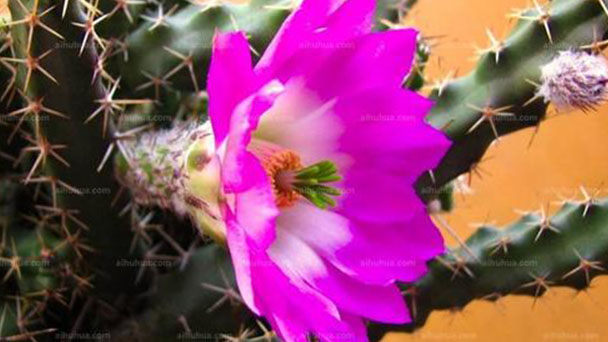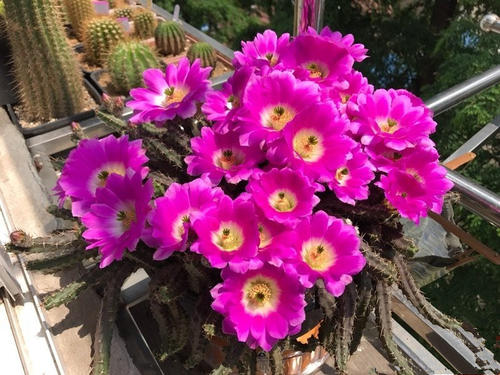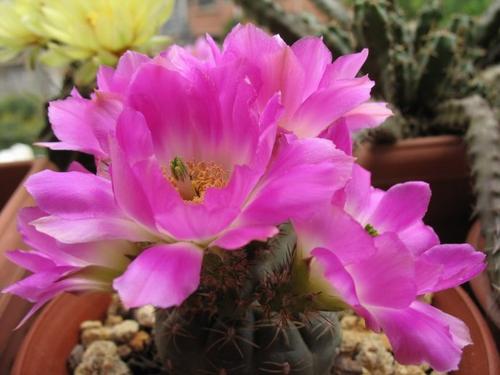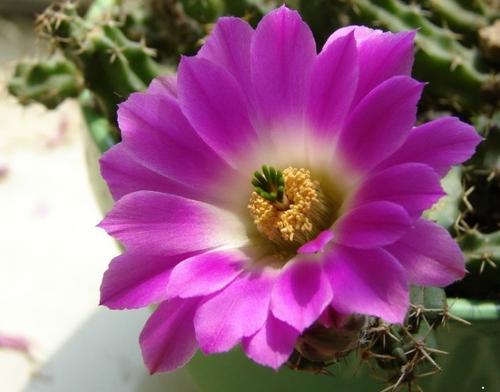Echinocereus pentalophus (ladyfinger cactus) profile
Written by Maggie
Feb 24 2021

Ladyfinger cactus, scientific name Echinocereus pentalophus, is a plant belonging to the genus Cactus in the cactus family. Ladyfinger cactus blossoms in spring and summer, with pink or rose flowers and cross-pollination. This variety is relatively tolerant to exposure to the sun, and it is dry during the growth period, so as to reduce the amount of water in the adult plant, otherwise it is easy to grow very long.
Ladyfinger cactus plants are large, globose or tubular. With sharp edges.Spines are hard and straight, often flat. The thorns are bright and bright. Spines with felt hairs, especially on the top of the ball, often with large pieces of felt hairs. The campanulate flower is terminal, yellow or pink, the fruit is thickly hairy.
Ladyfinger cactus picture

Morphological characteristics of Ladyfinger Cactus
Ladyfinger cactus plants are large, globose or tubular. ladyfinger cactus has sharp edges. Spines are hard and straight, often flat. The thorns are bright and bright. Spines with felt hairs, especially on the top of the ball, often with large pieces of felt hairs. Campanulate flowers are terminal, yellow or pink. The fruit is thickly hairy.
Ladyfinger cactus is a large plant with 5-6 edges, globular green, long stellate, basically pentagonal, prickly warts with 4-5 yellowish-white thorns on convex horn tips. Flowers bloom in spring and summer. Ladyfinger cactus has pink or rose flowers, silky leaves, flowers with 1 pistil and many stamens, yellow, cross-pollinated.
Ecological habits of Ladyfinger Cactus
Ladyfinger Cactus likes a warm and dry environment, requiring proper shade in summer and sufficient sunshine in winter. The growth temperature is 18 ~ 30℃, suitable for loose and fertile sandy loam growth.
Ladyfinger Cactus growing methods
Ladyfinger Cactus is relatively simple, perlite is mixed with peat, vermiculite and coal cinders, the proportion is random, breathable, and the soil surface is laid with pumice stone.
Ladyfinger cactus is relatively resistant to exposure, dry water in the growing period, adult plants try to reduce the amount of water, otherwise it is easy to grow very long, group growth of Ladyfinger cactus are relatively tall, not enough light is easy to grow tall.
The flowering period to see more sun is conducive to flowering, summer attention not to burn.
Ladyfinger cactus is very good to raise, paying attention to the sun is not too strong, when the summer growth of large water fat feeding, attention must be dry between two waterings.
Summer is the growing period of Ladyfinger Cactus, and the plants also need slight shading and ventilation. The high temperature period in summer basically requires semi-shading and ventilation maintenance, and the water is also dry from summer to winter. Throughout the cold winter, the temperature is lower than 2 degrees, can barely feed water, and then entered the Ladyfinger cactus dormant and less water can also prevent frostbite and roots rotted in low temperature, the soil under the condition of dry ladyfinger cactus is the low temperature resistant, kites in the sun room minus 4 degrees, ladyfinger cactus won't be any change, the temperature is in the sun room closed oh, kites are generally a basin of water are placed in the sun room, if the water is frozen, will heat up, as long as it's not in the open air, Ladyfinger Cactus can withstand such temperatures.
Ladyfinger Cactus growing water supply is basically dry and then feed water, generally kites do not cover the head, otherwise it may easily cause plant decay. This breed has no hair, it is not very easy to rot, but the water gets on the ball, the thorn will have a mark on the edge.Water supply must be gradual in spring, pay attention to the change of the weather.

Propagation of Ladyfinger Cactus
Ladyfinger cactus propagation is mainly seeding, but also grafting, but seeding growth is very slow, please be patient.
Species classification of Ladyfinger Cactus
There are not many species of this genus, but they are all classical species, which have been valued by botanical gardens and enthusiasts. Mexico and southwestern United States. Pyramid, Sun, Basalt, Shrimp, White Yuan, Da's Blue and White Shrimp, Ghost City, Bonfire, Ladyfinger Cactus, My Lady Brocade, Three Light Crown, Three Light Sphere, Moon Shadow Shrimp, White Yuan Shrimp, Universe Temple, Grey Shrimp, Wuyong Antler Pillar, Golden Dragon, Amaranth Jade, etc.
Ladyfinger Cactus flower language
Ladyfinger Cactus flower language is natural beauty.

Latest Updated
- Benefits of Bugleweed - 7 Science-backed Health Benefits
- Bugleweed Dangers & Side Effects - Is It Poisonous?
- How to Plant Evergreen Trees - What You Should Know
- When to Plant Evergreens - Grow Guide for Evergreen Trees
- 12 Wonderful Evergreen Shrubs for Your Garden
- 12 Popular Evergreen Plants with Pictures for Beginners
- When And How To Prune A Lilac Bush Like a Pro
- How to Grow & Care for Lilac Vine (Hardenbergia Violacea)
- Japanese Lilac Tree (Syringa Reticulata) Care & Propagation Guide
- Shumard Oak Pros and Cons - What to Know
Popular Articles
- Winter maintenance of Antirrhinum Majus
- How to Grow Terminalia Mantaly Tree
- How to Grow and Care for Crossostephium Chinense
- How to grow Antirrhinum Majus in spring
- Peristeria Elata (Dove Orchid) Profile: Info & Care Guide
- Underwatered Snake Plant (Sansevieria Trifasciata) - Signs And How To Fix
- How to Care for Brazilian Jasmine Plant (Mandevilla Sanderi)
- How to Grow & Care for Graptopetalum Purple Delight in Summer
- Rosa Chinensis (China Rose): Plant Growing & Care Tips
- How to Care for Baby Sun Rose (Aptenia Cordifolia)